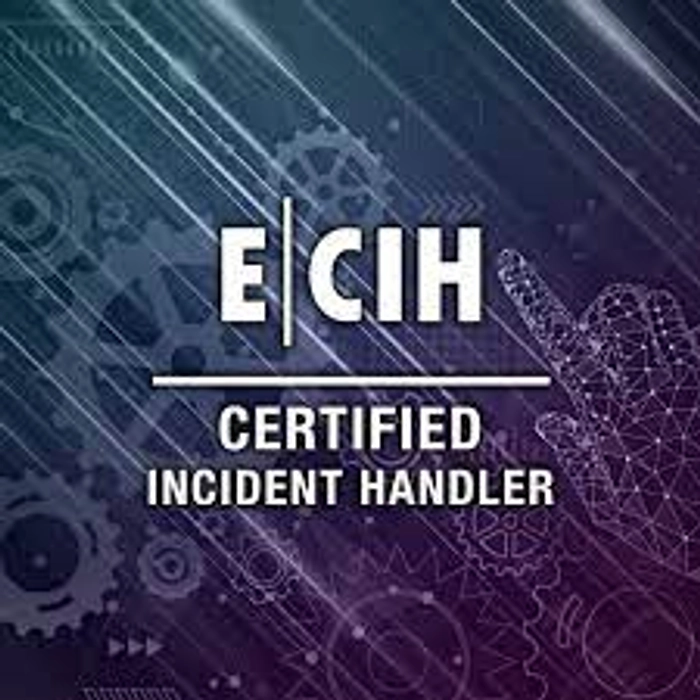EC-Council Certified Incident Handler v2
Product details
The EC-Council Certified Incident Handler (ECIH) program focuses on a structured approach for performing the incident handling and response (IH&R) process. The IH&R process includes stages like incident handling and response preparation, incident validation and prioritization, incident escalation and notification, forensic evidence gathering and analysis, incident containment, systems recovery, and incident eradication. This systematic incident handling and response process creates awareness among incident responders in knowing how to respond to various types of security incidents.
Cybersecurity Professionals interested in pursuing incident handling and response as a career require comprehensive training on the IH&R concepts as well as real-world scenarios. The ECIH program includes hands-on learning delivered through iLabs, online labs within the training program.
About the Certified Incident Handle (ECIH) Course
EC-Council’s Certified Incident Handler provides students with a method-driven program that uses a holistic approach to cover vast concepts concerning organizational incident handling and response from preparing and planning the incident handling response process to recovering organizational assets after a security incident. The skills taught in EC-Council’s ECIH program are desired by cybersecurity professionals from around the world and is respected by employers.
ECIH Course Benefits
- To enable individuals and organizations with the ability to handle and respond to different types of cybersecurity incidents in a systematic way.
- To ensure that organization can identify, contain, and recover from an attack.
- To reinstate regular operations of the organization as early as possible and mitigate the negative impact on the business operations.
- To be able to draft security policies with efficacy and ensure that the quality of services is maintained at the agreed levels.
- To minimize the loss and after-effects breach of the incident.
- For individuals: To enhance skills on incident handling and boost their employability.
Job Roles
- Penetration Testers
- Vulnerability Assessment Auditors
- Risk Assessment Administrators
- Network Administrators
- Application Security Engineers
- Cyber Forensic Investigators/ Analyst and SOC Analyst
- System Administrators/Engineers
- Firewall Administrators and Network Managers/IT Managers
ECIH is a specialist-level program that caters to mid-level to high-level cybersecurity professionals. In order to increase your chances of success, it is recommended that you have at least 1 year of experience in the cybersecurity domain.
ECIH members are ambitious security professionals who work in Fortune 500 organizations globally.
Note:
This is a DOD approved Course.
The aligned EC-Council Certified Incident Handler (ECIH) certification is approved by Army Credentialing Assistance (CA)
TARGET AUDIENCE
This course will significantly benefit incident handlers, risk assessment administrators, penetration testers, cyber forensic investigators, venerability assessment auditors, system administrators, system engineers, firewall administrators, network managers, IT managers, IT professionals and anyone who is interested in incident handling and response.
COURSE OBJECTIVES
After completing this course you should be able to:
- Understand the key issues plaguing the information security world
- Combat the different types of cybersecurity threats, attack vectors, threat actors and their motives, goals, and objectives of cybersecurity attacks
- Explain the fundamentals of incident management (information security incidents, signs and costs of an incident, incident handling and response and their advantages, etc.)
- Explain the fundamentals of vulnerability management, threat assessment, risk management, incident response automation and orchestration
- Master all incident handling and response best practices, standards, cybersecurity frameworks, laws, acts, and regulations
- Decode the various steps involved in planning incident handling and response program (Planning, Recording and Assignment, Triage, Notification, Containment, Evidence Gathering and Forensic Analysis, Eradication, Recovery, and Post-Incident Activities)
- Have an understanding of the fundamentals of computer forensics and forensic readiness
- Comprehend the importance of first response and first response procedure (Evidence collection, packaging, transportation, storing, data acquisition, volatile and static evidence collection, and evidence analysis)
- Find out anti-forensics techniques used by attackers to uncover cybersecurity incident cover-ups
- Apply the right techniques to different types of cybersecurity incidents in a systematic manner (malware incidents, email security incidents, network security incidents, web application security incidents, cloud security incidents, and insider threat-related incidents)
COURSE CONTENT
Introduction to Incident Handling and Response
- Overview of Information Security Concepts
- Understanding Information Security Threats and Attack Vectors
- Understanding Information Security Incident
- Overview of Incident Management
- Overview of Vulnerability Management
- Overview of Threat Assessment
- Understanding Risk Management
- Understanding Incident Response Automation and Orchestration
- Incident Handling and Response Best Practices
- Overview of Standards
- Overview of Cybersecurity Frameworks
- Importance of Laws in Incident Handling
- Incident Handling and Legal Compliance
Incident Handling and Response Process
- Overview of Incident Handling and Response (IH&R) Process
- Step 1: Preparation for Incident Handling and Response
- Step 2: Incident Recording and Assignment
- Step 3: Incident Triage
- Step 4: Notification
- Step 5: Containment
- Step 6: Evidence Gathering and Forensics Analysis
- Step 7: Eradication
- Step 8: Recovery
- Step 9: Post-Incident Activities
Forensic Readiness and First Response
- Introduction to Computer Forensics
- Overview of Forensic Readiness
- Overview of First Response
- Overview of Digital Evidence
- Understanding the Principles of Digital Evidence Collection
- Collecting the Evidence
- Securing the Evidence
- Overview of Data Acquisition
- Understanding the Volatile Evidence Collection
- Understanding the Static Evidence Collection
- Performing Evidence Analysis
- Overview of Anti-Forensics
Handling and Response to Malware Incidents
- Overview of Malware Incident Response
- Preparation for Handling Malware Incidents
- Detecting Malware Incidents
- Containment of Malware Incidents
- Eradication of Malware Incidents
- Recovery after Malware Incidents
- Guidelines for Preventing Malware Incidents
Handling and Responding to Email Security Incidents
- Overview of Email Security Incidents
- Preparation for Handling Email Security Incidents
- Detection and Containment of Email Security Incidents
- Eradication of Email Security Incidents
- Recovery after Email Security Incidents
Handling and Responding to Network Security Incidents
- Overview of Network Security Incidents
- Preparation for Handling Network Security Incidents
- Detection and Validation of Network Security Incidents
- Handling Unauthorized Access Incidents
- Handling Inappropriate Usage Incidents
- Handling Denial-of-Service Incidents
- Handling Wireless Network Security Incidents
Handling and Responding to Web Application Security Incidents
- Overview of Web Application Incident Handling
- Web Application Security Threats and Attacks
- Preparation to Handle Web Application Security Incidents
- Detecting and Analyzing Web Application Security Incidents
- Containment of Web Application Security Incidents
- Eradication of Web Application Security Incidents
- Recovery from Web Application Security Incidents
- Best Practices for Securing Web Applications
Handling and Responding to Cloud Security Incidents
- Cloud Computing Concepts
- Overview of Handling Cloud Security Incidents
- Cloud Security Threats and Attacks
- Preparation for Handling Cloud Security Incidents
- Detecting and Analyzing Cloud Security Incidents
- Containment of Cloud Security Incidents
- Eradication of Cloud Security Incidents
- Recovering from Cloud Security Incidents
- Best Practices Against Cloud-based Incidents
Handling and Responding to Insider Threats
- Introduction to Insider Threats
- Preparation for Handling Insider Threats
- Detecting and Analyzing Insider Threats
- Containment of Insider Threats
- Eradication of Insider Threats
- Recovery after Insider Attacks
- Best Practices Against Insider Threats



